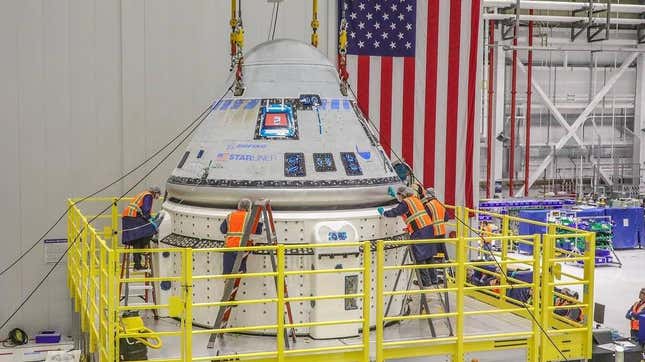Boeing’s Cursed Starliner Mission Delayed Due to ‘Small Helium Leak’

Boeing’s Cursed Starliner Mission Delayed Due to ‘Small Helium Leak’ (Image Credit: Gizmodo-com)

It’s deja vu all over again. Boeing’s long-anticipated Starliner mission has been postponed for a second time due to a newly discovered issue with the spacecraft’s service module.
On Tuesday, Boeing announced that liftoff for the first crewed test flight of its Starliner spacecraft is now targeted for May 21 at 4:43 p.m. ET. The company was originally targeting May 6 for the liftoff of Starliner on board United Launch Alliance’s (ULA) Atlas V rocket, but a last minute anomaly with one of the rocket’s pressure valves delayed the crewed test flight to May 17. ULA’s team successfully replaced the valve on Saturday, but now a new problem has arisen to push back the flight once again.
Related Content
“Starliner teams are working to resolve a small helium leak detected in the spacecraft’s service module traced to a flange on a single reaction control system thruster,” Boeing wrote in a statement. “NASA and Boeing are developing spacecraft testing and operational solutions to address the issue.”
The spacecraft consists of a reusable crew capsule and an expendable service module. Helium is used in the spacecraft’s thruster systems to allow the thrusters to fire without being combustible or toxic. To help resolve the issue, Boeing will test the spacecraft by pressurizing the propulsion system as it does before launch, and then allow the helium system to vent naturally. Mission teams will also look over the data of the last launch attempt to track any other issues, according to Boeing.
Boeing’s Crewed Flight Test is part of NASA’s Commercial Crew Program and is meant to transport crew and cargo to and from the International Space Station (ISS) under a $4.3 billion contract with the space agency. NASA’s other commercial partner, SpaceX, just launched its eighth crew to the space station.
Starliner is meant to carry NASA astronauts Butch Wilmore and Suni Williams to the ISS and back. Following the initial scrub, astronauts Wilmore and Williams exited the Starliner spacecraft and launch pad at Cape Canaveral Space Force Station in Florida and returned to the astronaut crew quarters at NASA’s Kennedy Space Center. The two astronauts are still in pre-flight quarantine, but they returned to Houston to spend some time with their families before liftoff, according to Boeing.
This is the latest in a string of mishaps and failures that have marred the Starliner program since its inception nearly a decade ago. Starliner’s first uncrewed test flight in 2019 managed to reach space, but a software automation glitch caused the spacecraft to burn excess fuel, preventing it from making it to the ISS.
The botched first flight prompted NASA to call for a second test flight of the empty spacecraft before a crew rides on board. In May 2022, Boeing completed the Orbital Flight Test-2 (OFT-2), but OFT-2 suffered a few hiccups, including the failure of a thruster used for orbital maneuvering. Despite the minor anomaly, NASA decided to go ahead with a crewed test flight anyway.
Boeing’s crewed Starliner launch was initially set for February 2023, then postponed to late April, and finally rescheduled for July 21, 2023. A few weeks before liftoff, however, the company announced that it was standing down from the launch attempt to address newfound issues with the crew vehicle, including a mile’s worth of flammable tape that had to be manually removed.
If we weren’t already nervous for the first launch attempt of Starliner’s crewed flight, there are more than enough reasons to make us worry at this point.
For more spaceflight in your life, follow us on X and bookmark Gizmodo’s dedicated Spaceflight page.








